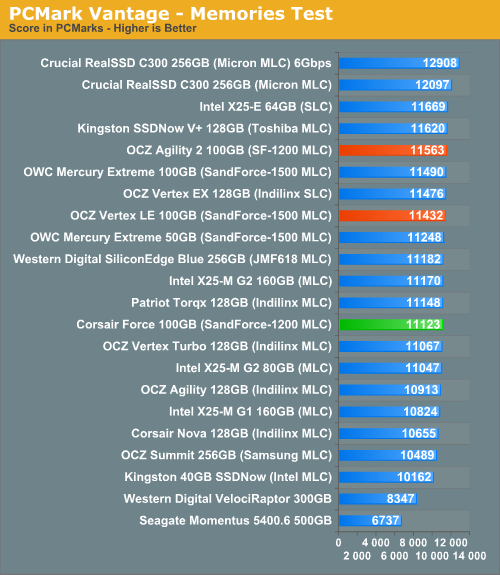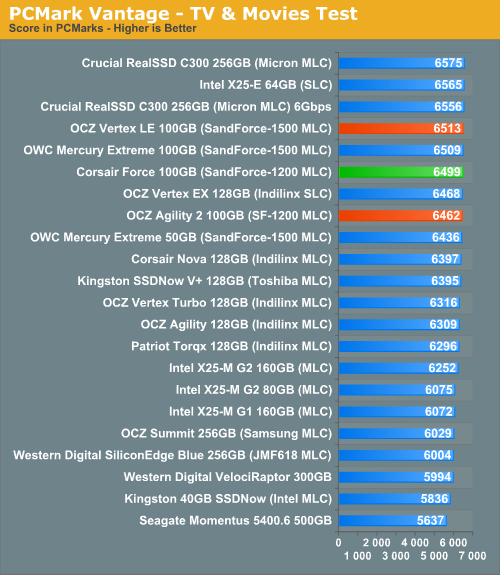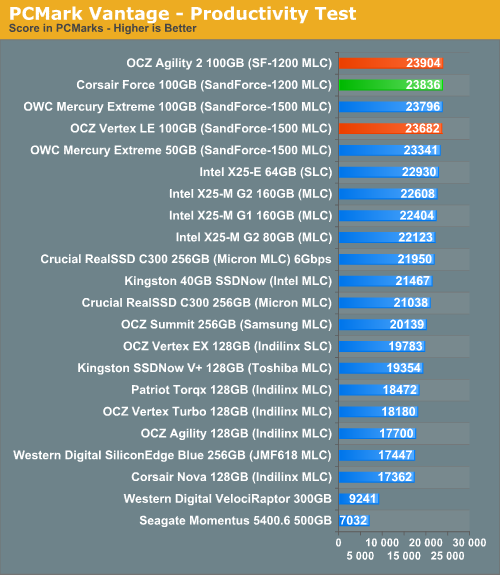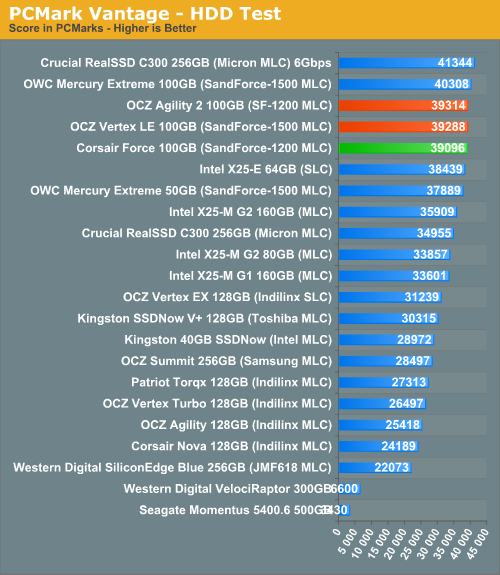OCZ's Agility 2 Reviewed: The First SF-1200 with MP Firmware
by Anand Lal Shimpi on April 21, 2010 7:22 PM ESTOverall System Performance using PCMark Vantage
Next up is PCMark Vantage, another system-wide performance suite. For those of you who aren’t familiar with PCMark Vantage, it ends up being the most real-world-like hard drive test I can come up with. It runs things like application launches, file searches, web browsing, contacts searching, video playback, photo editing and other completely mundane but real-world tasks. I’ve described the benchmark in great detail before but if you’d like to read up on what it does in particular, take a look at Futuremark’s whitepaper on the benchmark; it’s not perfect, but it’s good enough to be a member of a comprehensive storage benchmark suite. Any performance impacts here would most likely be reflected in the real world.

In real world performance the SandForce drives do very well. Crucial and SandForce based drives are the ones to beat. You're looking at around 5%+ performance improvement over Intel's X25-M series and even more compared to Indilinx.
The memories suite includes a test involving importing pictures into Windows Photo Gallery and editing them, a fairly benign task that easily falls into the category of being very influenced by disk performance.

The TV and Movies tests focus on on video transcoding which is mostly CPU bound, but one of the tests involves Windows Media Center which tends to be disk bound.

The gaming tests are very well suited to SSDs since they spend a good portion of their time focusing on reading textures and loading level data. All of the SSDs dominate here, but as you'll see later on in my gaming tests the benefits of an SSD really vary depending on the game. Take these results as a best case scenario of what can happen, not the norm.

In the Music suite the main test is a multitasking scenario: the test simulates surfing the web in IE7, transcoding an audio file and adding music to Windows Media Player (the most disk intensive portion of the test).

The Communications suite is made up of two tests, both involving light multitasking. The first test simulates data encryption/decryption while running message rules in Windows Mail. The second test simulates web surfing (including opening/closing tabs) in IE7, data decryption and running Windows Defender.

I love PCMark's Productivity test; in this test there are four tasks going on at once, searching through Windows contacts, searching through Windows Mail, browsing multiple webpages in IE7 and loading applications. This is as real world of a scenario as you get and it happens to be representative of one of the most frustrating HDD usage models - trying to do multiple things at once. There's nothing more annoying than trying to launch a simple application while you're doing other things in the background and have the load take forever.

The final PCMark Vantage suite is HDD specific and this is where you'll see the biggest differences between the drives:











60 Comments
View All Comments
speden - Wednesday, April 21, 2010 - link
I still don't understand if the SandForce compression increases the available storage space. Is that discussed in the article somewhere? Is the user storage capacity 93.1 GB if you write uncompressable data, but much larger if you are writing normal data? If so that would effectively lower the cost per gigabyte quite a bit.Ryan Smith - Wednesday, April 21, 2010 - link
It does not increase the storage capacity of the drive. The OS still sees xxGB worth of data as being on the drive even if it's been compressed by the controller, which means something takes up the same amount of reported space regardless of compressibility.The intention of SandForce's compression abilities was not to get more data on to the drive, it was to improve performance by reading/writing less data, and to reduce wear & tear on the NAND as a result of the former.
If you want to squeeze more storage space out of your SSD, you would need to use transparent file system compression. This means the OS compresses things ahead of time and does smaller writes, but the cost is that the SF controller won't be able to compress much if anything, negating the benefits of having the controller do compression if this results in you putting more data on the drive.
arehaas - Thursday, April 22, 2010 - link
The Sandforce drives report the same space available to the user, even if there is less data written to the drive. Does it mean that Sandforce drives should last longer because there are fewer actual writes to the NAND? One would reach the 10 million (or whatever) writes with Sandforce later than with other drives.Ryan Smith - Thursday, April 22, 2010 - link
Exactly.MadMan007 - Wednesday, April 21, 2010 - link
On a note somewhat related to another post here, I have a request. Could you guys please post final 'available to OS' capacity in *gibibytes*? (or if you must post gigabytes to go along with the marketers at the drive companies make it clear you are using GIGA and not GIBI) After I realized how much 'real available to OS' capacity can vary among drives which supposedly have the same capacity this would be very useful information...people need to know how much actual data they can fit on the drives and 'gibibytes available to the OS' is the best standard way to do that.vol7ron - Wednesday, April 21, 2010 - link
Attach all corrections to this post.1st Paragraph: incredible -> incredibly
pattycake0147 - Thursday, April 22, 2010 - link
On the second page, there is no link where the difference between the 1500 and the 1200 are referenced.Roland00 - Thursday, April 22, 2010 - link
The problem with logarithmic scales is your brain interprets the data linerally instead of exponentially unless you force yourself not too.Per Hansson - Thursday, April 22, 2010 - link
I agreeJust as an idea you could have the option to click the graph and get a bigger version, I guess it would be something like 600x3000 in size but would give another angle at the data
Because for 90% of your users I think a logramithic scale is very hard to comprehend :)
Impulses - Thursday, April 22, 2010 - link
Not sure if this is the best place to post this but as I just remembered to do so, here goes... I have no issues whatsoever with your site re-design on my desktop, it's clean, it's pretty, looks fine to me.HOWEVER, it's pretty irritating on my netbook and on my phone... On the netbook the top edge of the page simply takes up too much space and leads to more scrolling than necessary on every single page. I'm talking about the banner ad, followed by the HUGE Anandtech logo (it's bigger than before isn't it), flanked by site navigation links, and followed by several more large bars for all the product categories. Even the font's big on those things... I don't get it, seems to take more space than necessary.
Those tabs or w/e on the previous design weren't as clean looking, but they were certainly more compact. At 1024x600 I can barely see the title of the article I'm on when I'm scrolled all the way up (or not at all if I've enlarged text size a notch or two). It's not really that big a deal, but it just seems like there's a ton of wasted space around the site navigation links and the logo. /shrug
Now on to the second issue, on my phone while using Opera Mini I'm experiencing some EXTREME slowdowns when navigating your page... This is a much bigger deal, it's basically useless... Can't even scroll properly. I've no idea what's wrong, since Opera Mini doesn't even load ads or anything like that, but it wasn't happening a week or two ago either so it's not because of the site re-design itself...
It's something that has NEVER happened to me on any other site tho, they may load slow initially, but after it's open I've never had a site scrolls slowly or behave sluggishly within Opera Mini like Anandtech is doing right now... Could it be a rogue ad or something?
I load the full-version of all pages on Opera Mini all the time w/o issue, but is there a mobile version of Anandtech that might be better suited for my phone/browser combination in the meantime?